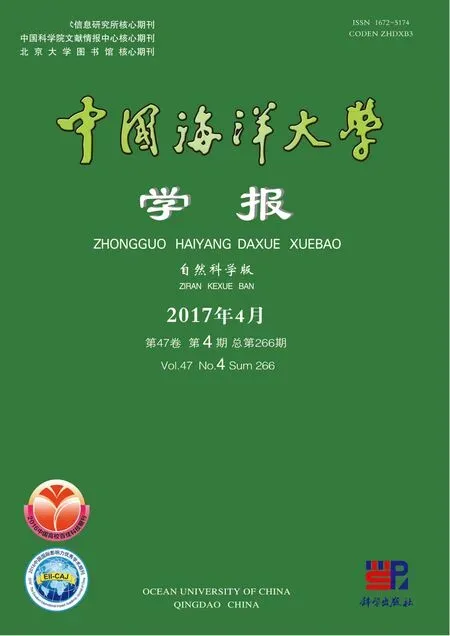硝酸盐存在对硫自养/电化学氢自养组合工艺还原高氯酸盐性能影响*
2017-01-12王雪礁李志伟高孟春
赵 堃, 张 健, 王 森, 郑 栋, 王雪礁, 李志伟, 高孟春,2**
(1. 中国海洋大学海洋生态与环境教育部重点实验室,山东 青岛 266100; 2. 中国海洋大学环境科学与工程学院,山东 青岛 266100)
硝酸盐存在对硫自养/电化学氢自养组合工艺还原高氯酸盐性能影响*
赵 堃1, 2, 张 健1, 2, 王 森1, 郑 栋1, 王雪礁1, 李志伟1, 高孟春1,2**
(1. 中国海洋大学海洋生态与环境教育部重点实验室,山东 青岛 266100; 2. 中国海洋大学环境科学与工程学院,山东 青岛 266100)
硝酸盐;高氯酸盐;硫自养还原;电化学氢自养还原
高氯酸盐是一种具有高度扩散性的持久性有毒污染物,被广泛地应用在军工生产、烟火工业、皮革加工、橡胶制造、染料与涂料生产等领域。由于高氯酸盐具有化学性质稳定和水溶性高的特点,能够持续迁移并造成大范围的地下水或地表水污染,人体摄入高氯酸盐后,它能干扰甲状腺素的合成和分泌,影响人体正常的新陈代谢。美国国家环保署先后在42个州的地下水、地表水和饮用水中发现了高氯酸盐,并将其列入候补污染物质表[1]。中国是烟花制造与消费、生产高氯酸钾及氧化添加剂的大国,存在着潜在的高氯酸盐污染源。刘勇建等[2]发现北京市部分给水处理厂的原水和出水中含有高氯酸盐。张萍等[3]在澳门的自来水中也检测到了高氯酸盐,说明了我国许多饮用水水源已经受到了高氯酸盐的污染。
1 材料与方法
1.1 实验装置
硫自养/电化学氢自养组合工艺主要由进水池、蠕动泵、硫自养段、氢自养段和直流电源五部分组成。硫自养段由内径为75 mm、高为40 cm的机玻璃制成,内部填充粒径为3~4 mm的硫颗粒(S0)作为填料,在距离底部1、10、20和30 cm处分别设置取样口。氢自养段由内径为75 mm,高为20 cm不锈钢筒外壁作为阴极,以位于不锈钢筒中央的直径为2.5 cm、长为25 cm的圆柱型石墨棒作为阳极,并在阳极和阴极之间填充粒径为3~4 mm的石墨增碳剂。氢自养段在距离底部60和60 cm处分别设置取样口。表1为不同运行阶段的运行参数。实验装置工艺流程如图1所示。
1.2 进水水质
1.3 分析方法
2 结果与讨论
2.2 不同运行阶段硫自养电化学氢自养组合工艺对硝酸盐的还原效果
2.5 不同运行阶段硫自养/电化学氢自养组合工艺出水pH的变化
(1)
0.5N2+0.08C5H7O2N 。
(2)
3 结论
[1] Gullick R W, Lechevallier M W, Barhorst T S. Occurrence of perchlorate in drinking water sources[J]. Journal of the American Water Works Association, 2001, 1993(1): 66-77.
[2] 刘勇建, 牟世芬, 林爱武, 等. 北京市饮用水中溴酸盐、卤代乙酸及高氯酸盐研究[J]. 环境科学, 2004, 25(2): 51-55. Liu Y J, Mou S F, Lin A W, et al. Investigation of bromate, Haloacetic acids and perchlorate in Beijing’s Drinking water[J]. Environmental Science, 2004, 25(2): 51-55.
[3] 张萍, 史亚利, 蔡亚岐, 等. 改进的离子交换色谱法测定环境水样中的高氯酸盐 [J]. 高等化学学报, 2007, 28(7): 1246-1250. Zhang P, Shi Y L, Cai Y Q, et al. An improved ion chromatography method for determination of trace level perchlorate in environmental water[J]. Chemical Journal of Chinese Universities, 2007, 28(7): 1246-1250.
[4] Gu B, Brown G M, Chiang C C. Treatment of perchlorate-contaminated groundwater using highly selective, regenerable ion-exchange technologies[J]. Environmental Science and Technology, 2007, 41: 6277-6282.
[5] Roach J D, Tush D. Equilibrium dialysis and ultrafiltration investigations of perchlorate from solution using poly (diallyldimethylammonium) chloride[J]. Water Research, 2008, 42: 1204-1210.
[6] Wang Z C, Gao M C, Zhang Y. Perchlorate reduction by hydrogen autotrophic bacteria in a bioelectrochemical reactor[J]. Journal of Environmental Management, 2014, 142: 10-16.
[7] Srinivasan R, Sorial G A. Treatment of perchlorate in drinking water: a critical review[J]. Separation and Purification Technology, 2009, 69: 7-21.
[8] Xu J, Song Y, Min B, et al. Microbial degradation of perchlorate principles and applications[J]. Environmental Engineering Science, 2003, 20: 405-422.
[9] Brown J C, Anderson R D, Min J H, et al. Fixed bed biological treatment of perchlorate-contaminated drinking water[J]. Journal of American Water Works Association, 2005, 97: 70-81.
[10] Giblin T L, Herman D C, Frankenberger W T. Removal of perchlorate from ground water by hydrogen-utilizing bacteria[J]. Journal of Environmental Quality, 2000, 29: 1057-1062.
[11] Nerenberg R, Rittmann B E. Hydrogen-based, Hollow-fiber membrane biofilm reactor for reduction of perchlorate and other oxidized contaminants[J]. Water Science and Technology, 2004, 49(11-12): 223-230.
[12] Logan B E, Lapoint D. Treatment of perchlorate-and nitrate-contaminated groundwater in an autotrophic, gas phase, packed-bed bioreactor[J]. Water Research, 2002, 36: 3647-3653.
[13] Nerenberg R, Kawagoshi Y, Rittmann B E. Microbial ecology of a perchlorate-reducing, hydrogen-based membrane biofilm reactor[J]. Water Research, 2008, 42: 1151-1159.
[14] Ju X M, Sierra-Alvarez R, Field J A, et al. Microbial percholorate reduction with elemental sulfur and other inorganic electron donors[J]. Chemosphere, 2008, 71: 114-122.
[15] Sahu A K, Conneely T, Nusslein K R, et al. Biological perchlorate reduction in packed bed reactors using elemental sulfur[J]. Environmental Science and Technology, 2009, 43: 4466-4471.
[16] Koening A, Liu L H. Kinetic model of autotrophic denitrification in sulphur packed-bed reactors[J]. Water Research, 2001, 35: 1969-1978.
[17] Sahu A K, Conneely T, Nüsslein K R, et al. Biological perchlorate reduction in packed bed reactors using elemental sulfur[J]. Enivronmental Science and Technology, 2009, 43: 4466-4471.
责任编辑 庞 旻
ZHAO Kun1, 2, ZHANG Jian1, 2, WANG Sen1, ZHENG Dong1,WANG Xue-Jiao1, LI Zhi-Wei1, GAO Meng-Chun1, 2
(1.The Key Laboratory of Marine Environmental Science and Ecology, Ministry of Education, Ocean University of China, Qingdao 266100, China; 2.College of Environmental Science and Engineering, Ocean University of China, Qingdao 266100, China)
国家自然科学基金项目(21077096)资助
2016-04-13;
2016-05-27
赵 堃(1985-),男, 博士生。E-mail:dragoon83123@163.com
** 通讯作者:E-mail: mengchun@ouc.edu.cn
O611.65
A
1672-5174(2017)04-100-06
10.16441/j.cnki.hdxb.20160128
赵堃, 张健, 王森, 等. 硝酸盐存在对硫自养/电化学氢自养组合工艺还原高氯酸盐性能影响[J]. 中国海洋大学学报(自然科学版), 2017, 47(4): 100-105.
Supported by the National Natural Science Foundation of China (21077096)
